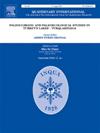Highland settling in the Early Mesolithic. Insight from the record of Cima Dodici open-air sites, Venetian pre-Alps (Italy)
IF 1.9
3区 地球科学
Q3 GEOGRAPHY, PHYSICAL
引用次数: 0
Abstract
Large areas of the Italian Alps were home to early Holocene hunter-gatherers, who exploited the highlands seasonally throughout the entire Mesolithic period. This is evident on the southern slope of Cima Dodici, a peak located along the northernmost fringe of the Asiago Plateau, where sites are distributed between 2000 and 2100 m of elevation, representing a unique context for investigating Mesolithic settlement patterns at the onset of Holocene. This work integrates previous excavation data, re-evaluation of surface collections, and the analysis of the spatial distribution of lithic assemblages from two excavated sites, providing an updated framework for understanding the sites and their main characteristics. Despite potential post-depositional disturbances, the pattern at CD3 reveals a possible organization of activities, with designated areas for specific tasks. In contrast, the spatial distributions at CD9 appear to be influenced by the accumulation of artifacts in depressions. Surface collection data from other sites provide additional information about the settlement network and potential functional differences between sites, although the scarcity of diagnostic artifacts in some assemblages, limits interpretation. Overall, the study highlights the complexity of Mesolithic settlement pattern on the Asiago Plateau, highlighting adaptations to the specific environmental conditions of mid and high-altitude settlings.
中石器时代早期的高地定居。从威尼斯前阿尔卑斯山西马多迪奇露天遗址的记录中获得的启示(意大利)
意大利阿尔卑斯山脉的大片地区是全新世早期狩猎采集者的家园,他们在整个中石器时代季节性地利用高地。这在Cima Dodici的南坡上表现得很明显,Cima Dodici是位于阿齐亚戈高原最北端边缘的一个山峰,那里的遗址分布在海拔2000到2100米之间,代表了全新世开始时研究中石器时代定居模式的独特背景。本研究整合了之前的挖掘数据、对地表收集的重新评估以及对两个出土遗址的岩石组合空间分布的分析,为了解这些遗址及其主要特征提供了一个更新的框架。尽管有潜在的沉积后干扰,CD3的模式揭示了一种可能的活动组织,有特定任务的指定区域。相反,CD9的空间分布似乎受到洼地中人工制品积累的影响。来自其他地点的地表收集数据提供了关于聚落网络和地点之间潜在功能差异的额外信息,尽管在一些组合中缺乏诊断性人工制品,限制了解释。总体而言,该研究突出了阿齐亚戈高原中石器时代聚落模式的复杂性,突出了中、高海拔聚落对特定环境条件的适应。
本文章由计算机程序翻译,如有差异,请以英文原文为准。
求助全文
约1分钟内获得全文
求助全文
来源期刊

Quaternary International
地学-地球科学综合
CiteScore
5.60
自引率
4.50%
发文量
336
审稿时长
3 months
期刊介绍:
Quaternary International is the official journal of the International Union for Quaternary Research. The objectives are to publish a high quality scientific journal under the auspices of the premier Quaternary association that reflects the interdisciplinary nature of INQUA and records recent advances in Quaternary science that appeal to a wide audience.
This series will encompass all the full spectrum of the physical and natural sciences that are commonly employed in solving Quaternary problems. The policy is to publish peer refereed collected research papers from symposia, workshops and meetings sponsored by INQUA. In addition, other organizations may request publication of their collected works pertaining to the Quaternary.
 求助内容:
求助内容: 应助结果提醒方式:
应助结果提醒方式:


